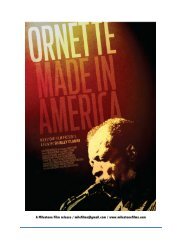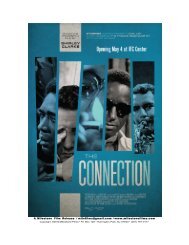ORNETTE Press Kit.8.7.2012 - Shirley Clarke
ORNETTE Press Kit.8.7.2012 - Shirley Clarke
ORNETTE Press Kit.8.7.2012 - Shirley Clarke
Create successful ePaper yourself
Turn your PDF publications into a flip-book with our unique Google optimized e-Paper software.
cool jazz genre was not even possible without key players’ heroin use. In the heroin-‐<br />
induced cool of the film, isolation pours through every pore of the image stream and the<br />
jazz score.<br />
The Cool World was the first commercial film set in Harlem (Dizzy Gillespie cameos) and<br />
was a prototype for such filmmakers as Spike Lee. That same year she won an Oscar for her<br />
documentary on U.S.A. Poet Laureate Robert Frost, a very different cultural type!<br />
Portrait of Jason (1967), is possibly the greatest ‘talking head’ film of all time, though in<br />
actuality, it does not fit into any category, but explores in an ad nauseam digression, the<br />
possibilities of verité. The camera remains steadfastly stationary as the subject, an ageing<br />
alcoholic gay hustler-‐slash-‐would-‐be nightclub performer, gradually loses inhibitions in the<br />
course of the interview, and creates his ultimate performance. It is a contemplative<br />
narrative: Jason describes and enacts his outrageous life; the director/camera is the still<br />
meditator on that life. The viewer becomes, over the course of the film, acutely aware of the<br />
fact that, although Jason moves more and more the camera does not, in a marathon of<br />
motionlessness. This contrasts with all her other works. It is edited from a single 12-‐hour<br />
session, and she releases the subject to develop his own rhythms, physical intellectual and<br />
emotional, like a Dadaist ‘found’ choreography. Jason (Aaron Payne) is simultaneously the<br />
most fascinating and banal person you could ever meet.<br />
Betty Boop and the Avant Garde<br />
<strong>Clarke</strong> was acutely aware of the role of the avant garde in popular culture, as a sort of<br />
siphon for The New.<br />
She had 2 personal symbols which make an appearance in each of her films: Betty Boop, the<br />
character created by legendary animator Max Fleischer, and Felix the Cat, cartoons both<br />
created in the 1930’s. Betty Boop was the sex symbol of early animation, a flapper from the<br />
Jazz Age, with surreal, sexual and complex psychological elements, and I always felt that<br />
<strong>Clarke</strong> identified herself with that character, even dressed like her, however I doubted that<br />
she could have kept up with a rendition of The Lindy by Betty Boop. Felix the Cat was an<br />
irreverent animation, like <strong>Shirley</strong>’s nonconformist character. Known for his huge grin, Felix<br />
nevertheless smoked, frowned, and played jazz. Both cartoons had elements of vaudeville,<br />
both came out of the jazz age.<br />
She also passionately loved Busby Berkeley, the film choreographer of massive<br />
kaleidoscopic numbers, circa 1940’s. She would mention him admiringly during video work<br />
in Ornette. The sex sequence towards the end of Ornette, with its unfolding flowers and<br />
winking women, is strongly reminiscent of Berkeley’s hallucinogenic musical number, “I<br />
Only Have Eyes for You,” in the film Dames. Dames prompted Warner Brothers to coin the<br />
term cinematerpsichorean, which is also a good term for <strong>Shirley</strong>’s work.<br />
30




